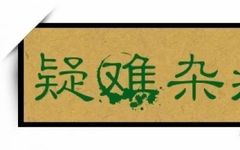Sheng Tian Nan Xing (Raw Arisaema) Vinegar Paste for Abscess Treatment
Sheng Tian Nan Xing 9-15g, ground into a fine powder, mixed with vinegar to form a paste, applied to the affected area 1-2 times daily. This external formula is effective in dispersing swelling and resolving abscesses, primarily treating pediatric abscesses. Sheng Tian Nan Xing is pungent and bitter, warm in nature, and toxic. According to “Ben Cao Cong Xin,” it can “disperse wind, move blood, and eliminate swelling,” commonly used for external treatment of abscesses, scabies, and bites from poisonous snakes and insects. The “Tie Gu San” mentioned in “Yang Yi Da Quan” uses this herb to treat various swellings and toxins.
Case Study: Liu, male, 1.5 years old. The child experienced excessive sweating during the summer and did not wash promptly, leading to summer heat and sweat damaging the skin, resulting in over ten abscesses of varying sizes on the head, neck, and chest, with five larger ones becoming soft and purulent but not yet ruptured, red, swollen, and painful, causing distress. Administered Sheng Tian Nan Xing 15g, ground into powder, mixed with vinegar to form a paste, after local disinfection, applied to the abscesses twice daily for five days. The larger ones gradually shrank until they ruptured and discharged pus, while the others dissipated.

Huang Yu You (Yellow Elm Oil) for Pemphigus Treatment
Sheng Da Huang (Raw Rhubarb) and Sheng Di Yu (Raw Rehmannia) each 15g, ground into a fine powder, after cleaning the wound, sprinkled or mixed with sesame oil and applied to the affected area several times daily. This external formula has detoxifying and wound-healing properties, primarily treating pemphigus. According to “Wai Ke Zheng Zong,” “Pemphigus is caused by excessive heart fire and dampness from the spleen…” with the disease stemming from both “fire” and “dampness”. Da Huang is a bitter and cold herb, effective in clearing heat and detoxifying, particularly good at draining heart fire, while Di Yu is bitter, sour, and cold, with a sinking and astringent nature, functioning to stop bleeding and heal wounds. The combination of these two herbs provides a dual approach: one detoxifies, and the other heals wounds.
Case Study: Wang, male, 1 year old. During the hot and humid season, the child experienced excessive heart fire damaging the skin, resulting in blisters on the abdomen and lower limbs, with the blisters being translucent and filled with clear fluid, some already ruptured, leaving bright red, painful wounds. Administered this formula mixed with sesame oil and applied to the affected area for three days, resulting in the wounds drying and scabbing over.
Lu Dai San (Aloe Powder) for Oral Ulcer Treatment
Lu Dai San consists of 3g of Aloe and 1.5g of Qing Dai (Indigo). The herbs are ground into a fine powder and stored in a clean, sealed bottle. Using a disinfected cotton swab, apply to the affected area 3-5 times daily. Lu Dai San has detoxifying and tissue-regenerating properties, primarily treating oral ulcers. Aloe is bitter and cold, used externally for treating skin conditions like scabies, hemorrhoids, rhinitis, and lymphadenitis. Qing Dai is salty and cold, effective in clearing heat, detoxifying, and cooling blood, used externally for treating skin ulcers, scabies, and nosebleeds. Both herbs are cold in nature, effective in clearing heat, detoxifying, and healing ulcers caused by heat. This formula is effective for oral ulcers caused by heat.
Case Study: Wang, male, 11 years old, presented with oral ulcers. Examination revealed red lips, with ulcerations on the tip of the tongue and lower lip, each about the size of duckweed, causing burning pain, aversion to food, dry mouth, and a foul odor. The diagnosis indicated accumulation of heat in the heart and spleen, scorching the mouth, leading to oral ulcers. Administered this external treatment, and after two days, the ulcers on the lips and tongue had healed.
Sheng Lu San (Raising Furnace Powder) for Eczema Treatment
Sheng Lu San consists of 3g of Huang Sheng (Lead Powder), 15g of Lu Gan Shi (Calamine), 6g of Ku Fan (Alum), 1.5g of Bing Pian (Borneol), and 9g of Ku Shen (Sophora). The herbs are ground into a fine powder and applied to the affected area using disinfected cotton. If the wound is dry, it can be mixed with sesame oil to form a thin paste and applied with a clean brush 1-2 times daily. Sheng Lu San has heat-clearing, detoxifying, and moisture-absorbing properties, primarily treating eczema. Huang Sheng can detoxify and promote tissue regeneration, effective for treating “wind, scabies, leprosy, and blood wind” (as per “Yang Ke Xuan Cui”); Lu Gan Shi absorbs moisture and heals wounds, effective for non-healing ulcers and skin dampness; Ku Fan dries moisture and absorbs fluid, particularly effective for ulcerated, oozing, and itchy skin; Bing Pian disperses heat, reduces swelling, and alleviates itching and pain, essential for treating external wind and dampness; Ku Shen clears heat and dries dampness, particularly effective for treating “scabies, pus-filled sores, skin itching, and blood wind” (as per “Dian Nan Ben Cao”). Sheng Lu San is particularly suitable for eczema caused by wind and damp heat.
Case Study: Cui, female, 5 years old. The child presented with dense vesicular rashes on the limbs and perineum, with severe itching, constantly scratching, and yellow fluid oozing, with some areas already crusted. Initially, a decoction of wild chrysanthemum and plantain (fresh or dried) was used to wash the affected area, followed by applying the above powder, resulting in immediate relief from itching, and all rashes disappeared after five days.

